The Duomo di Milano, Milan’s magnificent Gothic cathedral, is one of the world’s largest churches. Its dazzling white front facade, arguably the world’s most beautiful, dominates the cathedral square.
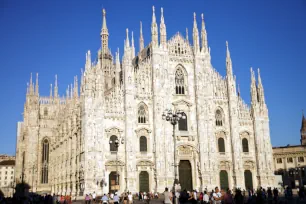
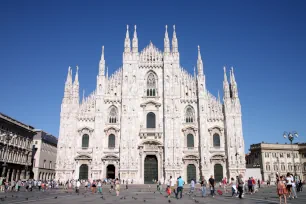
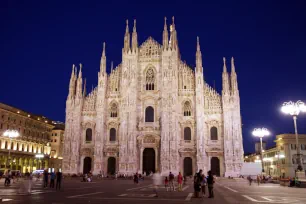
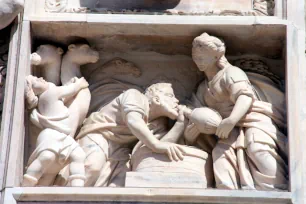
The Duomo is literally at the center of Milan. Streets radiate from the cathedral or circle it. The cathedral occupies a site that has been the most central location in the city since its founding.
Building the Cathedral
The construction of the cathedral was commissioned by bishop Antonio da Saluzzo in 1385. He was supported by the first duke of Milan, Gian Galeazzo Visconti, who envisioned the creation of the world’s largest church. He gave access to his marble quarries, granted tax exemptions and invited architects from across Europe.
Construction commenced in 1386, but it would drag on for centuries. When the cathedral was consecrated in 1418, construction of the nave had only just started. Construction would continue until 1813, and final finishes were applied as late as in 1965.
Over the years, numerous master builders were involved, and the initial design was continuously altered to become even more spectacular. The long construction period also led to a mash-up of a variety of styles, but the final result is surprisingly homogenous, with a decidedly flamboyant Gothic design.
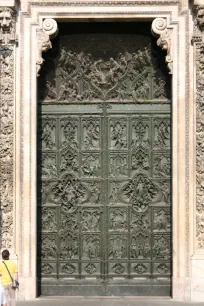
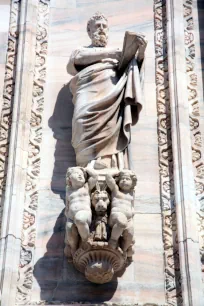
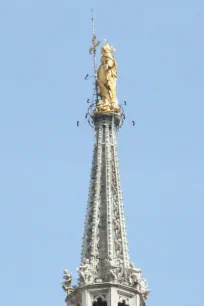
Exterior
After completing the foundation and plinth of the cathedral, work focused on the apse. This part is considered the architectural highlight of the church, and its Gothic design was influenced by master builders who hailed from Germany. Work then progressed slowly towards the front.
It wasn’t until the nineteenth century before the Duomo’s most imposing element, the front facade facing Piazza del Duomo, was completed. The five bronze doorways also look a lot older than they actually are. The central one is the oldest and was created in the nineteenth century by Ludovico Pogliaghi. The other doors were created in the mid-twentieth century; the fifth doorway is the most recent, and was created as recent as in 1965. The panels on the doors depict episodes in the lives of the Virgin Mary, Saint Ambrose (patron of Milan) and Saint Charles Borromeo as well as scenes from the history of Milan and the construction of the cathedral.
Statuary
The Duomo is decorated with an amazing number of beautifully sculpted statues and spires. There are more statues on this building than any other in the world, 3159 in total. 2245 of these are on the exterior together with 96 gargoyles and 135 spires. It is said that if the statues were placed on top of each other, they would reach a height of about 5300 meters (3.3 mi).
The most famous of all these is the Madonnina (Little Madonna), a copper statue of the Virgin Mary covered with 3900 pieces of gold leaf. It was cast in 1774 by goldsmith Giuseppe Bini and sculptor Giuseppe Perego. The statue, four meters and sixteen centimeters tall (almost 14 ft), was placed on top of the cathedral’s tallest spire and until 1959 marked the highest point in the city at 108.5 meters.
Interior
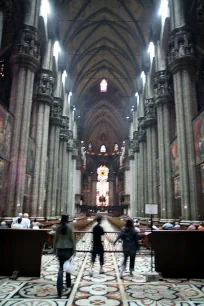
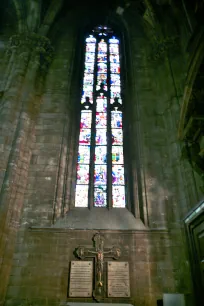
The inside of Milan’s Cathedral is expansive but rather dark. There are five large naves divided by fifty-two pillars – one for each week of the year – that support the cross vaulted ceiling.
Of particular note inside the cathedral are a number of architectural pieces and works of art, including a statue of St. Bartholomew by Marco d’Agrate. There are three wonderful altars designed by Pellegrino Pellegrini, all of which include some excellent art, such as the renowned Visit of St. Peter to St. Agatha Jailed by Federico Zuccari. Other masterpieces include the Renaissance marble altar in the right transept and the Trivulzio Candelabrum, the base of which was crafted in the twelfth century and features imaginary animals, vegetables, and vines. Also notable is a spot above the apse that is marked with a red light bulb. This is supposedly the spot where one of the nails used in Jesus’s crucifixion was placed.
Roof
After exploring the inside, visitors can pay a small fee to take a fascinating trip to the Duomo’s roof via steps or elevator. It’s amazing to walk among the forest of spires, and the view from the roof is unmatched. On a clear day, you can see as far as the Alps and Apennines. The roof is quite safe and should pose no problems even for those afraid of heights.
